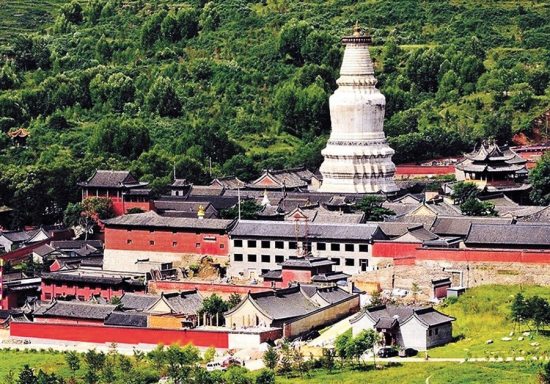Wutai Mountain steeped in meaning
 0 Comment(s)
0 Comment(s) Print
Print E-mail Shanghai Daily, May 8, 2015
E-mail Shanghai Daily, May 8, 2015

Home to the Bodhisattva of Wisdom, or Wenshu in Chinese, Wutai Mountain in Shanxi Province has long been regarded as one of the country's most sacred mountains.
Pilgrims flock to Wutai Mountain to pray for knowledge and guidance. Tourists go for the wonderful vistas.
The Bodhisattva is believed to frequently appear on the mountain, taking the form of monks, or a five-colored cloud rising from its five terrace-like peaks that gives Wutai its name.
Wutai Mountain National Park is on average about 1,000 meters above sea level. The North Terrace, the highest of its five peaks, soars about 3,058 meters above sea level and is covered with snow throughout the year. It is often called the "Roof of north China."
The best time to visit Wutai Mountain is from April to September, when flowers in the area are in bloom and the weather is cool and pleasant. With clear skies and gorgeous surroundings, the mountain is regarded as an ideal place to escape the summer heat and is also referred to as "Clear Cool Mountain."
Wutai Mountain is one of the rare areas that contain both Buddhist temples and Tibetan Buddhist monasteries, some built as early as the Han Dynasty (202 BC-AD 220). More than 90 still exist. Some have been rebuilt, repaired or expanded through the years. This is one of the few places where one can see the changes in architectural styles over different dynasties.
The Big White Pagoda for Buddha's Sarira, the symbol of Wutai Mountain, is said to have been built in the Yuan Dynasty (1271-1368). The pagoda features a Nepalese style and has a base in a size triple that of the White Pagoda in Beijing's Beihai Park.
Inside the pagoda there is a small Indian made iron stupa, where some remains of Sakyamuni are kept. To the right of the stupa is Buddha's footprint; and to the left, a stone tablet with inscriptions recording the refurbishing of the pagoda during the Qing Dynasty (1644-1911).
There are 115 prayer wheels surrounding the pagoda. Each bear Buddhism's "Six Truest Words" mantra — Om mani padme hum — in English. Due to an enduring relationship with Tibetan Buddhism, Wutai Mountain is China's only holy mountain where both Chinese Buddhism and Tibetan Lamaism are practiced on China's mainland.
Nanchan Temple dates back 1,200 years. The main hall is the earliest wooden structure of its kind preserved in China today. It houses 17 painted Buddhist figurines of various shapes.
Xiantong Temple is the oldest temple in the country and also the biggest on Wutai Mountain. It was originally built in the Eastern Han Dynasty (AD 25-220).







Go to Forum >>0 Comment(s)